We are rocketing through October, or so it seems! Maybe it is just me, but I am always surprised to see Hallowe`en appearing on the horizon. And there is not a lot of chance of missing it now. Yes, we will be having a special event so if you have anything deliciously spooky in your collection do send it along and we will feature it (not too much goriness, thank you, I do have my limits....)

Hignett, Bros. & Co. [tobacco : UK] "Beauties" - set 2 medium size (1927) 26/50 - H536-620.2 : H44-61.2 : RB.21/231-2
Lets start with a new slant on National Chess Day, for "Chess Cigarettes" was a brand of Hignett, Bros. & Co, as you can see here, but if it looks unfamiliar that is because it was an export brand, to New Zealand, where it was issued through British American Tobacco. They reinforce the gaming theme by using a chess board pattern on the reverse. However I have not found any other cards issued with the brand. I have found a packet illustrated on Pinterest but I am not a member there so I only get a bit of the image.
The set 2 is the most important part in identification, for there is a set 1, with exactly this same reverse. You can only tell the sets apart by the cards included, which are different from each other. They both measure 64 x 41 m/m as well.
The Dodge Sisters, posing here, appear in a still from "Suppertime", a C.B. Cochran revue which was hosted at the Trocadero Grill Rooms. These were wigs, as they were dark haired. One sister was called Betty Jane, the other Beth, or Dora. They sometimes said they were twins, but they were just very similar sisters. One popular part of their act involved a sheet of glass in a frame, with one of them copying whatever the other did as if in a mirror. Often, as part of publicity, contests were held asking people to tell which sister was which. I have not come across any other cards of them, but do please tell if you know of any.

W.A. & A.C. Churchman [tobacco : UK] "Modern Wonders" (February 1938) 18/48 - C504-590 : C82-67
The Boulder Dam, on the Colorado River, was first considered a feasible spot for generating electricity in 1902, but not constructed between 1931 and 1936. There were also almost three hundred miles of transmission lines to make ready too. Our card marks the fact that it was on October 9, 1936 that electricity was first sent, to Los Angeles in California.
When the Dam was first thought of, it was called the Boulder Dam, a kind of unofficial nod to the fact that it was in a place which was known as Boulder Canyon. Actually it wasn`t, it had been moved slightly, nearer to Black Canyon, but the name stuck. Then, in September 1930, at its official starting ceremony, when a spike was driven into the ground, much in the way the pioneers would start a railway, it was suddenly announced that it was to be named after the then President of the United States, Herbert Hoover. This was most unpopular, for in the midst of the Great Depression, Hoover was bearing the brunt of the blame. Many people refused to change, and stuck firmly to the original name. In fact for a while it had two names, scathingly referred to as the hidden name "Hoover", which continued to be used on the official documents, and the peoples` name of "Boulder". Eventually, in 1933, when Hoover was voted out of the Presidency, the Dam was given the official name of Boulder Dam again, and it was as that when in 1935 President Roosevelt opened it. And our card dates from just a few years later.
The Boulder Dam also appears on Godfrey Phillips "This Mechanized Age" first series (1936) 18/50. The text on that tells us that it cost "33 million pounds ... creates an artifical lake 115 miles long, and took 4 1/2 years to construct. The lake will take two years to fill, and the controlled waters will be used as an electric power station ... "
And it is also on Hitchmans Dairies "Modern Wonders" (1965) 18/25 - plus the "Alike" series issued by Comet Sweets of Slough.

Now I am going to take you back in time, not quite as far as this card shows, but not too far away from it in looks. When I was growing up my Nan used to go out down to the local shops with her basket just after eleven and pick the thing she most wanted to eat for dinner, just one portion, plus any trimmings that she did not have at home in her cupboard of ingredients. She would bring it home, cook it and eat it. Later on, she would repeat the same process for her tea. There was no waste, and no storage, and she didnt even have a fridge.
Now I know that most of us are too busy to do this, but is this not what we should be aiming towards, rather than driving miles to the superstore and buying a whole trolley of food which will either go off or just not be wanted? You may counter this by saying that the superstore is cheaper, and it is, but it is at the expense of the local stores which used to do its job, and of the people it employed. Superstores may have power to buy in bulk, and to sell for less, but we give them that power. And it is time to start taking it back.
Shift10 Day was founded in 2016, by Scott`s Marketplace, as a way to do just this. They asked that starting today you spend 10% of your weekly shopping budget, or pleasure fund, in a small local shop, or several, that you think how pleasant it is, and maybe that you do a bit more shopping there in weeks to come. And it works for collectables too - so why not check your local collectors shop at least once a week rather than always shopping online. This saves postage, and postal loss or damage, and you are in less chance of being sniped at the very last second and spending all day like a grumpy bear. Best of all it will also allow you to have a chat to a new friend, who runs the store, as well as make a small collectables dealer a bit more happy with every sale we get. More importantly it keeps us ticking along, and it keeps us in business.
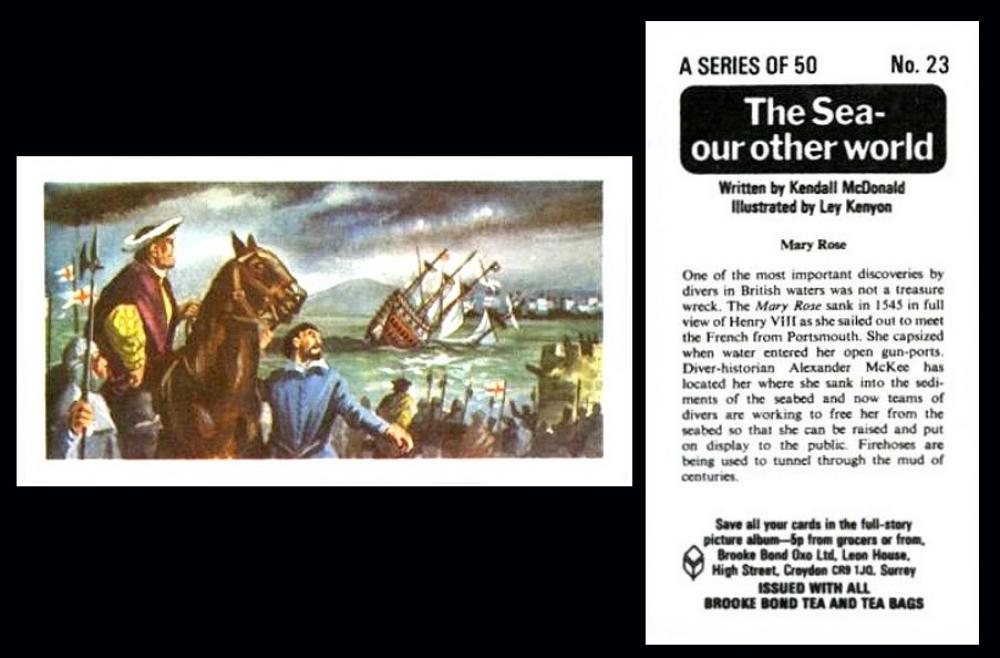
Brooke Bond [trade : UK : tea] "The Sea - Our Other World" (1974) 23/50 - BRM-59
Only one code for this is after 1970 - and that comes from our original set of Trade Indexes.
Today in 1982, Henry VIII`s favourite ship, the Mary Rose, was raised from its watery tomb and brought to the surface. And that was forty years ago this year.
You can read much more about her, and see her, at the official site https://maryrose.org/ But briefly, she had gone beneath the waters in July 1545, but that was not, as is popularly thought, her maiden voyage, for she had sailed for over thirty years, and in many waters by the time she sank. And she fought as the flagship of the Navy in the Battle of St Mathieu in August 1512.
Her construction was first mooted in 1510, as one of two new vessels. These were built in Portsmouth and called Mary Rose and Peter Pomegranate. Some say Mary was named for the future Queen, but it is more likely they were saints. The floral suffixes do have proven meaning, for they were the symbols of Henry VIII (the Tudor Rose) and his wife, Katharine of Aragon (the pomegranate). Henry had a heavy hand in the design of both, and he wanted them to be subtly different. Peter Pomegranate was more of a fast fighting ship, whilst Mary Rose was to be a gun ship, with cannons ready and waiting, that could fire through open holes in the sides, above the water line.
Her end came swiftly, amidst the Battle of the Solent. Nobody really knows what happened on that day but somehow in the heat of the fight the ship started to list, and in righting herself she listed more the other way, water started to come in through the open holes and suddenly she was sinking, fast. Over 450 men were lost, and the ship too. And, as our card shows, King Henry VIII was watching from the shoreline.
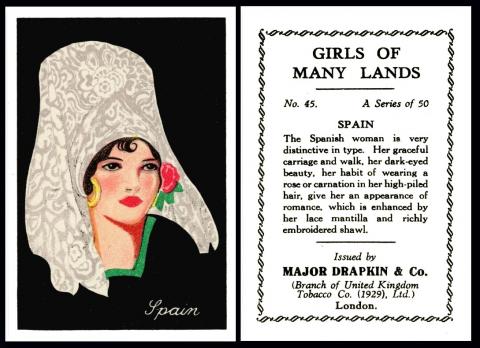
Major Drapkin [tobacco : UK] "Girls of Many Lands" (1929) 45/50 - D800-525 : D64-28 : RB113/411
Today is the Fiesta Nacional de Espana, or the National Day of Spain. In that country it is a National Holiday, mixing respect, remembrance, and much festivity. It also celebrates the Spanish legacy across the World, including their territories in South and Central America, where events are also held. In addition it is the official day of the Spanish Language and its derivatives, the day of the Spanish Armed Forces who protect their Country and take part in an annual parade. It is the date of at least two Saints Days. And finally, and, perhaps, not coincidentally, it also commemorates the very day that Christopher Columbus is said to have discovered America.
Our card shows a Spanish lady set for a festival or celebration of some kind. This is the medium sized version, measuring 76 x 52 m/m but it was also issued in slightly smaller than the standard size at 63 x 37 m/m. Our larger set was either scarcer or more popular from very early on, for in 1950 it was retailed at 1/6d each for odds and a very hefty 100/- for a full set, which makes it the most expensive set by this maker in the London Cigarette Card Company catalogue of that year - the only other 100/- Drapkin issue was a part set, 38/40, of "Colours and Badges of the Indian Army".
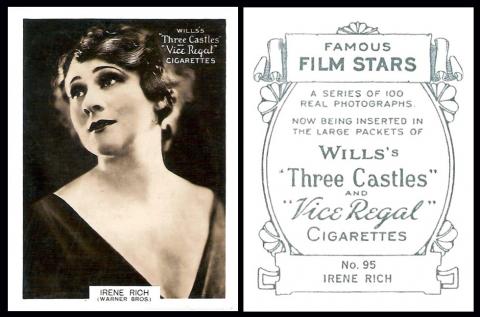
Today in 1891, Irene Luther was born in Buffalo, New York.
When she was quite young her family ran into trouble financially and they relocated, several times. She married in 1909 at the age of seventeen, and was divorced after two years, leaving her with a daughter. Then she met a soldier in the US Army, and they were married; his name was Charles Rich, from where she got her stage surname from, and she had another daughter. She remained married for four years, but it again ended in divorce, shortly after the birth of her second daughter.
Now she had two small children to support, so she started working as what we call an estate agent, selling homes and land. I am not sure whether this failed, but fairly shortly after she started acting, perhaps as a way to pass the time, or more likely to look after her daughters. She was an extra, a face glimpsed in a crowd, if you are not busy with the popcorn or your date. Her first real break is when she is billed fourth in a film called "The Girl in His House" starring Earle Williams and Grace Darmond, a former serials queen now playing it more dramatically.
Two years after this she was teamed with Will Rogers, who really liked her, and continued to use her in his movies for many years; by the coming of sound she often played his wife. She was a wife in real life again by this time, marrying for the third time in 1927. This was again a short spell, and after four years she was a three time divorcee.
About this time she started appearing on the radio, in fact she had her own show, The Irene Rich Show. She was involved, or at least named, in a rather messy love triangle that created a bit of a stir in the papers, and she was married again, in 1950. This lasted until he died in 1959, and she never wed again, she just stayed on at his ranch and died there in 1988.
The Trading Card Database has her on nine cards, but they are for the most part pretty obscure sets. However I can add another one, R & J Hill "Famous Cinema Celebrities" (1932) series 19/50. Any more out there?
![Fry [trade : UK : cocoa] "Birds & Their Eggs"](/sites/default/files/styles/large/public/2022-10/14%20egg.jpg?itok=nrgW88ml)
Fry [trade : UK : chocolate and cocoa] "Birds and Their Eggs" (1914) 1/24 - FRY-100 : FRY-2 : HX-164
Today is World Egg Day. The egg is a perfect thing in all respects, with its soft and precious cargo being protected by a hard to break shell. More wonderful, the newly created chick has a special way to break it from the inside when it is time to release themselves into their new life and new World.
Oh that more got to hatch and less got eaten for breakfast. I can only do my small part by not eating them, and many thanks to my current dog who eats them for me, and to dogs past who did the same. Blame goes to a teacher who told me she found a chick in her egg when I was too tiny to be told such a horrible thing. And a quick plug for Radiohead, because it is their song "Paranoid Android" that causes me to call eggs unborn chickens. Its on YouTube if you want to listen in..
Here we have the Kingfisher, indeed one of the most beautiful birds, though you seldom get more than a glimpse before they have flashed past you.
First thing I notice is the bottom line of the reverse - "Makers to H.M. The King". Has anyone seen this yet on their grocery? I suppose it must be there already somewhere, lets see if we can find the first....
Now the HX reference means that it has other issuers, these are
-
Buchanan`s - jam (1924) BUC-050 - "Birds"
-
Chocolat de Villers (date unknown) CHO-020.1
-
John Filshill Ltd - confectionery (1924) FIL-210 - "Birds"
-
MacGirr (1912) MAC-270 - "Birds"
-
Typhoo - tea (1914) TYP-110 - "British"
More about these later, but I could use a hand with the blanks, notably locations, and with whatever it was that MacGirr produced. Many thanks in advance.
This week's Cards of the Day...
have been celebrating National Golf Lovers Day which was on Tuesday. As this sounds more of an appreciation of enjoyment than a serious day we have tried to find you some unusual cards that you might not have come across before. And here is what we found....
Saturday, 1st October 2022

The clue here was on the reverse, where Mr. Smith was referred to as "The Iron Man of Soccer", and an Iron is a kind of golf club, in fact they make up the bulk of the clubs in any bag, for they are suitable for many purposes rather than being specialised for one use.
The reason for the single code is the date of issue, for it is post 1970, and those issues are not in our current British Trade Index, they only appear in the four volume set which were originally published from 1962.
I do, however, have the original New Issues Report from the Cartophilic Notes and News magazine, it is extracted from Volume 5, no.56 of March-April 1974.

And if you want to see all the cards in this set, just nip over to Australia, to Nigel`s Webspace / Barratt Football Stars
Sunday, 2nd October 2022
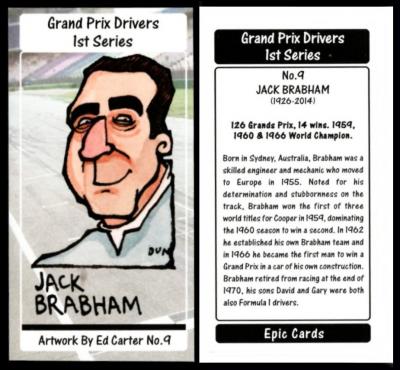
Of course the clue here was "Driver", another kind of club, which is longer and bigger than an iron, giving it more heft as it were to drive the ball forwards at speed.
Have found a bit more about these, the two sets, each of ten cards, were issued in 2019 and there was also a set of European Footballers, maybe two, again from artwork by Ed Carter, who I now know also draws footballers - check out Two Hundred Per Cent. But I still dont know where Epic Cards were based or what happened to them. If you know more do please tell me.
Our subject, Jack Brabham, is well known to all motor racing enthusiasts. But if he is not know to you check out his F1 fansite
Monday, 3rd October 2022

The cunning code word here was a bit of a teaser, for it was another golf club, a "mashie" - like you can mash-ie potatoes. Dreadful, I know, but I bet you at least smiled - hope so anyway.
Most places will just tell you that a mashie is a number five iron, but it did have a specific purpose of lofting the ball into the air.
This card is one of my favourite sets, and it is also propaganda in many ways. The obvious one was to encourage women to take up the jobs vacated by the men who were going off to war - and by 1916 it was already very evident that there would be a shortage in the labour force for some years due to the number of casualties and deaths. However it also must have suggested to many women, especially those who had been inspired by the Suffragettes, that they may be allowed to experience a life that they would never have been.
Some of the jobs on these cards are simple ones, like on our card, which even says that women in country areas would have always helped in the fields, but not town ones. However there are thrilling ones too, motor and ambulance driving, bus or tram conductor, guard on a railway train. Now though women had driven cars since 1897, the first woman bus conductor stepped aboard in November 1915. This was in London, but it was almost certainly inspired by Glasgow`s decision, earlier in the same year, to hire female tram drivers.
Sadly Carreras was not given a reference book all their own - and our World Tobacco Issues Index has just a brief description, namely "WOMEN ON WAR WORK. Sm. Nd. (50)"
Tuesday, 4th October 2022
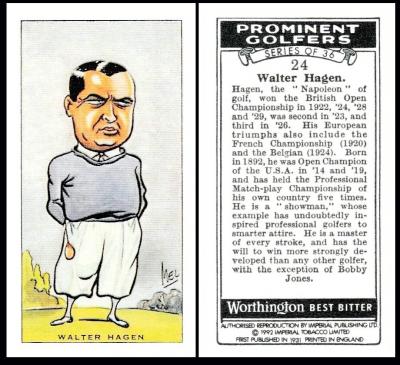
This is a curious tale, for at first glance you may think that here we have the 1931 Ogdens set of "Prominent Golfers". But if you look closer on the front, where you would expect to have an issuer`s name, it is not there.
Turning over the card it clearly states that this card was instead issued with Worthingtons Best Bitter, and is an authorised reproduction by Imperial Publishing Ltd.
It also says "a series of 36" - so you might get to wondering who was left out from the original set of fifty cards. And the answer is most of them, for this set is a marriage, made up of six cards from several standard sized sport related sets.
Now as I like doing strange and laborious tasks, I have had the most enormous fun working through the original sets and constructing one of my lists, this containing all the numbers of those people in their original sets.
"Association Footballers" (W.D. & H.O. Wills - 1935)
- 1. S. Cullis - Wolverhampton Wanderers (12)
- 2. J. Mercer - Everton (35)
- 3. E. Drake - Arsenal (12)
- 4. V. Woodley - Chelsea (49)
- 5. S. Matthews - Stoke City (34)
- 6. T. Lawton - Everton (28)
"Cricketers 1928" (W.D. & H.O. Wills - 1928)
- 7. C. Hallows - Lancashire (17)
- 8. Hon. F.S.G. Calthorpe - Warwickshire (4)
- 9. Mr. D.R. Jardine - Surrey (25)
- 10. W. Rhodes - Yorkshire (35)
- 11. H. Sutcliffe - Yorkshire (42)
- 12. Mr. P.G.H. Fender - Surrey (12)
"Men of the Moment in Sport" (all being tennis) (W.A. & A.C. Churchman - 1928)
- 13. J. Borotra (11)
- 14. Karel Kozeluh (39)
- 15. Rene Lacoste (40)
- 16. H.W. Austin (35)
- 17. E. Higgs (38)
- 18. H. Cochet (37)
"Prominent Golfers" (Churchman Ltd - 1931)
- 19. Bobby Jones (25)
- 20. T.H. Cotton (9)
- 21. Miss Joyce Wethered (45)
- 22. Abe Mitchell (29)
- 23. James Braid (5)
- 24. Walter Hagen (16)
"Jockeys 1930" (Ogdens Ltd - 1930)
- 25. H. Wragg (49)
- 26. F. Winter (48)
- 27. H. Beasley (6)
- 28. C. Elliott (15)
- 29. S. Donoghue (14)
- 30. G. Richards (39)
"Rugby Internationals" (Churchman - 1935)
- 31. H. Boughton (3)
- 32. R. C. S. Dick (19)
- 33. E. S. Nicholson (13)
- 34. D. Thomas (39)
- 35. W. Wooller (40)
- 36. W.H. Weston (15)
So does that make it a reproduction, to be avoided, or a tribute, to be collected.
I would be very interested to hear from you about what you think?
Wednesday, 5th October 2022

Here we have C. O. [Charles Owen] Hezlet . What is not stated is that he was entitled to add D.S.O., a medal he won during his time in the Antrim Royal Garrison Artillery, where he was a Lieutenant/Acting Major. And in the Second World War, in the Royal Artillery, he appears to have won the Military Cross.
Golfing was in his blood, his parents were captains of Royal Portrush and his sisters very talented players. He was actually runner up in the 1924 Amateur Championship. After the war he resumed his golfing and appeared in the Walker Cup Team three times.
This card comes from artwork by H. H. Harris, a very interesting character whose first name was Herbert. He was a poster artist and his big claim to fame was to design the advertisement with the pyjama clad man clinging to the neck of a Bovril jar - just months before the news of the Titanic sinking. It was not used for eight years. He also illustrated books for children and on sporting subjects, reputedly his illustrations for a golfing volume got his this job for Wills. He also drew another set of cigarette cards Wills "Lawn Tennis 1931". During the Second World War he toured round the airbases in a caravan sketching portraits of service personnel raising money for the RAF Comforts Fund. You can see him at work at the Mary Evans Picture Library
First reported in our original Wills Reference Book, part four as large sized cards, measuring 79 x 62 m/m.
They were replaced in November 1930 by "Beautiful Homes", a set of 25 large cards.
Thursday, 6th October 2022

This set is actually a game, and it is snap, there are four cards of each sport, and curiously for an English set one of those games is baseball. The others are Tennis, and Boxing.
There is a really fascinating article about this set written by "Pre War Cards" that also includes some very important information about this very card. Have a look, and do let us know what you think about that, especially if you are a golfing fan. I will pass on any info that we can combine.
Like most games of this kind there was an instruction leaflet, but dont worry if you have the set and no leaflet for it is reproduced in full at the Football Cartophilic Exchange / Drapkin
Friday, 7th October 2022

This is the last unusual card of the week, and it is also an unusual size at 70 x 35 m/m. They are rectangular as usual, but have the addition of two inverted triangular cut outs. The reason for those is that if you got all the cards in this series, put them together as a brick of cards, wound a rubber band around it at those triangles, and flicked through the cards with your fingers, it would give the impression that the golfer was actually striking the ball.
Yes, younger readers, this is the 1930s version of VR.
John Cotton Ltd were founded in the 1770s but only started to make cigarettes in 1920. They are stated to have been based at 172 Easter Road in Edinburgh, but that address, at least the yard, was in use from 1890 to 1920 by a T. J. Meldrum, a sculptor who also made cement and artificial stone. Not sure how these two would have co-existed. Or was it that John Cotton were elsewhere first, and moved into these premises, in 1920, where they started making cigarettes? That sounds more likely. So we just need to find out where they were first.
The company were still trading in 1956, when our original World Tobacco Issues Index was published, but in 1962 they were taken over by Gallaher.
Their brands were "Carolina", "Charter" and "Golden Virginia".
They only issued two sets, the other being "Bridge Hands Folders", issued in 1934, and measuring 82 x 66 m/m.
In our original World Tobacco Issues Index this set was known to be one of three -
1. as ours, with A on one side and B on the other (1936) - 2. C and D (1937) - and - 3. E and F (1938)
And it was later discovered that there were two more sets, which are very rare -
4. G and H (1939) - and - 5. I and J (1939)
With that knowledge, lets head over to Pre War Cards / John Cotton for a secret I bet hardly any of you know, because I didnt either.
Our subject, Archie Compston, or more correctly Archibald Edward Wones Compston, was born in 1893 in Wolverhampton. I am not sure why he was chosen as the model, but he was a very proficient golfer who played in the U.S. Open twice, the first ever Ryder Cup, and in a seventy-two hole special match against Walter Hagen, which was played at the supremely magnificent course at Moor Park. Compston won. However it could well be the single fact that he was the golfing coach of Edward, Prince of Wales, later to become, briefly, Edward VIII, and his brother George VI, later to inherit the vacant throne.
Well sadly that is all I have time for tonight. However the index is coming along really well and it should be up soon. I am also working on the updates page, so that is something else for you to look forward to. And finally I am writing an article for our Christmas magazine, but that is for members only.
